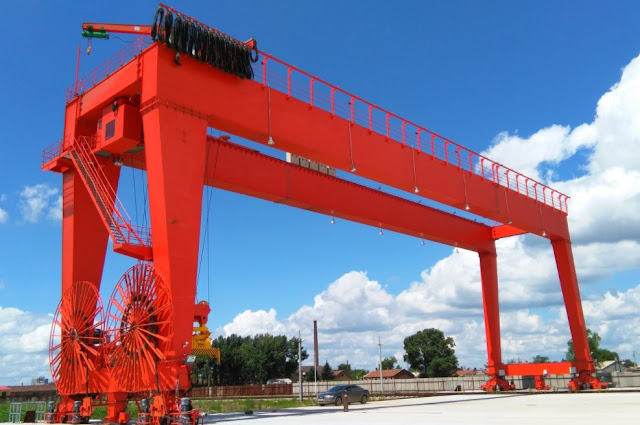Automated Rail-Mounted Gantry Crane: Advancing Efficiency in Container Handling
In the bustling world of container handling at ports and terminals, efficiency and productivity are of paramount importance. To meet the demands of modern logistics and to streamline container operations, automated rail-mounted gantry cranes (ARMGs) have emerged as game-changers. These advanced machines combine the reliability and versatility of traditional rail-mounted gantry cranes with cutting-edge automation technology, resulting in faster, safer, and more efficient container handling. In this article, we will explore the features, advantages, and potential impact of automated rail-mounted gantry cranes in the container handling industry.
Understanding Automated Rail-Mounted Gantry Cranes
Rail-mounted gantry cranes have long been a staple in container terminals, serving as essential workhorses in lifting, transferring, and stacking containers. Traditional rail-mounted gantry cranes are operated by skilled operators who control their movements, lift loads, and position containers manually. However, the rapid growth in container traffic and the need for enhanced operational efficiency have driven the development of automated solutions.
Automated rail-mounted gantry cranes (ARMGs) integrate state-of-the-art automation technology into the traditional gantry crane design. These advanced machines are equipped with an array of sensors, cameras, and sophisticated control systems that allow them to operate autonomously. Automated cranes are guided by advanced positioning systems, such as laser or GPS, to accurately position themselves and precisely handle containers without the need for human intervention.
Features and Advantages of Automated Rail-Mounted Gantry Cranes
Increased Productivity and Throughput
One of the most significant advantages of automated rail-mounted gantry cranes is their ability to drastically increase productivity and terminal throughput. Automated cranes operate with consistent precision, allowing for faster handling of containers and minimizing the time required for each operation. The autonomous nature of ARMGs enables them to work around the clock, without the need for shift changes or breaks, leading to continuous and efficient container handling.
Additionally, ARMGs can be synchronized and coordinated with other automated systems, such as automated guided vehicles (AGVs) and stacker cranes, to create a seamless and highly productive container handling ecosystem.
Improved Safety and Reliability
Automated rail-mounted gantry cranes enhance safety by reducing the risk of human error. With skilled operators no longer required to manually control the crane's movements, the potential for accidents caused by misjudgments or fatigue is significantly reduced. Automated cranes also come equipped with advanced collision avoidance systems, which prevent accidents and improve overall terminal safety.
Moreover, the automation of container handling processes ensures consistent and reliable operations. ARMGs adhere to pre-programmed routes and movements, eliminating inconsistencies in container placement and reducing the risk of equipment damage.
Space Optimization and Energy Efficiency
ARMGs are designed with space optimization in mind. By operating autonomously, they can be closely positioned, maximizing the use of available yard space. Their precise movements and stacking accuracy allow for tighter container stacking, leading to more efficient use of valuable terminal real estate.
Furthermore, automated rail-mounted gantry cranes are energy-efficient. The automation systems allow for better control of power consumption, optimizing the crane's movements and reducing unnecessary energy expenditure. This energy-saving feature contributes to overall cost reduction and aligns with sustainability goals.
Integration with Terminal Operating Systems (TOS)
Automated rail-mounted gantry cranes can be seamlessly integrated with Terminal Operating Systems (TOS). TOS is a central control system that manages various terminal operations, including container tracking, yard planning, and equipment coordination. By connecting ARMGs with TOS, terminal operators gain real-time insights into crane performance and container handling efficiency. This integration allows for data-driven decision-making, better resource allocation, and improved overall terminal management.
Scalability and Future-Readiness
The adoption of automated rail-mounted gantry cranes provides terminals with the flexibility to scale their operations as container traffic grows. By adding more ARMGs, terminals can expand their capacity without significant infrastructural changes. Additionally, the autonomous nature of ARMGs positions terminals to embrace future developments in automation and robotics, ensuring they remain at the forefront of container handling technology.
Conclusion
Automated rail-mounted gantry cranes represent a significant leap forward in the container handling industry. Their integration of automation technology with the versatility and reliability of traditional gantry cranes has revolutionized container terminal operations. The advantages of increased productivity, improved safety, space optimization, energy efficiency, and integration with Terminal Operating Systems make automated rail-mounted gantry cranes a strategic investment for modern container terminals.
As container traffic continues to grow, the adoption of ARMGs will become increasingly vital in meeting the demand for efficient, safe, and future-ready container handling solutions. By embracing automation, terminals can enhance their competitive edge, optimize resource allocation, and elevate overall operational performance in the dynamic world of container logistics.



Comments
Post a Comment